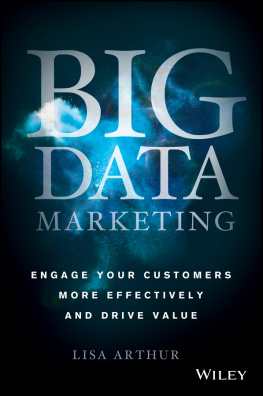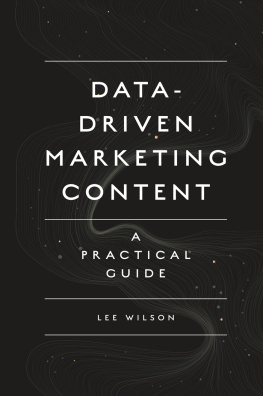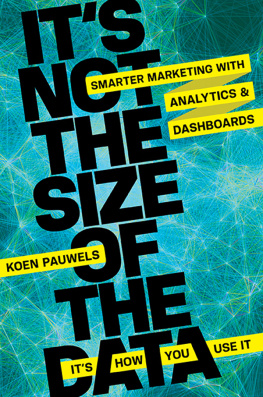
Cover image: Studio 504/Getty Images
Cover design: Paul McCarthy
Copyright 2013 by Lisa Arthur. All rights reserved.
Published by John Wiley & Sons, Inc., Hoboken, New Jersey.
Published simultaneously in Canada.
No part of this publication may be reproduced, stored in a retrieval system, or transmitted in any form or by any means, electronic, mechanical, photocopying, recording, scanning, or otherwise, except as permitted under Section 107 or 108 of the 1976 United States Copyright Act, without either the prior written permission of the Publisher, or authorization through payment of the appropriate per-copy fee to the Copyright Clearance Center, 222 Rosewood Drive, Danvers, MA 01923, (978) 750-8400, fax (978) 646-8600, or on the web at www.copyright.com. Requests to the Publisher for permission should be addressed to the Permissions Department, John Wiley & Sons, Inc., 111 River Street, Hoboken, NJ 07030, (201) 748-6011, fax (201) 748-6008, or online at www.wiley.com/go/permissions.
Limit of Liability/Disclaimer of Warranty: While the publisher and author have used their best efforts in preparing this book, they make no representations or warranties with the respect to the accuracy or completeness of the contents of this book and specifically disclaim any implied warranties of merchantability or fitness for a particular purpose. No warranty may be created or extended by sales representatives or written sales materials. The advice and strategies contained herein may not be suitable for your situation. You should consult with a professional where appropriate. Neither the publisher nor the author shall be liable for damages arising herefrom.
For general information about our other products and services, please contact our Customer Care Department within the United States at (800) 762-2974, outside the United States at (317) 572-3993 or fax (317) 572-4002.
Wiley publishes in a variety of print and electronic formats and by print-on-demand. Some material included with standard print versions of this book may not be included in e-books or in print-on-demand. If this book refers to media such as a CD or DVD that is not included in the version you purchased, you may download this material at http://booksupport.wiley.com. For more information about Wiley products, visit www.wiley.com.
ISBN: 978-1-118-73389-9 (cloth)
ISBN: 978-1-118-73402-5 (ebk)
ISBN: 978-1-118-73405-6 (ebk)
For my love, my muse, and my true north, Michael Bloom.
For my butterfly mom, Betty Burris.
Foreword
Why did you get into marketing? I am guessing that it's not because you had a burning desire to refine propensity models until the wee hours of the morning, or to wrestle with integrating social media comments with web clickstream data. But those are exactly the kinds of activities that make marketers great these days. The function is undergoing a dramatic transformation toward a world of data-driven decisions that this book describes in detail. You may have gravitated toward marketing because it is one of the most creative areas of business, and you still need to possess that attribute to succeed. But creativity is increasingly judged not only in the human imagination, but also in clickthroughs, conversions, and lift.
Marketing is not, of course, the only area of business undergoing this transformation. Few people enter the retail industry because they have a fascination with point-of-sale data, and few baseball fans want to work for a team so they can compute its Pythagorean winning percentage. The world in general is becoming more data-driven, and the change in marketing is only one example of that overall shift.
However, as Lisa Arthur details in the chapters that follow, the change in marketing is especially dramatic. In little more than a decade, the function has gone from emphasizing pretty pictures and catchy phrases to one that captures, integrates, and analyzes data of all types. Needless to say, many marketersand the managers outside the function who relate to marketersare not quite prepared for this transformation. They've heard the noise about data-driven marketing, but they're hoping they can retire before they really have to change their entire orientation.
But unless they're well into their sixties, retirement won't help much. Every day, marketing assets become increasingly digitized. Every day, more information about customers' preferences and behaviors becomes available. Every day, the opportunity cost of not pursuing data-driven marketing piles up.
There is both an organizational and an individual imperative for reading this book, internalizing its lessons, and continuing the pursuit of data-driven marketing. At the organizational level, some group of people needs to take the lead within companies in moving toward a data and analytics-focused culture. Marketing, as the function most impacted by the rise of dataand as the most frequent gatherer and user of customer datais in an excellent position to take the lead and to lead by example. If marketing can target customer promotions, understand the attribution of digital media to sales, and segment to markets of one, the rest of the organization can't help but move in the same data-driven direction.
If marketing takes the lead in this regard, it can also seize an opportunity to take primary responsibility for managing customer interaction data. As you probably realize, marketing is not the only customer-oriented function in most organizations. It shares that responsibility with sales and customer service. My view is that over the next several years, organizations will feel the need to clarify who is really responsible for customer information. If marketing groups can demonstrate that they are adept at managing and using customer informationand making the data accessible to other organizations that need itthere's a good chance that marketing will get the role for the entire organization.
Of course, in order to do that successfully, marketing will need to step up its professionalism in data management. As Arthur points out, that means discipline, a process orientation, and lots of work on data integration. These are not generally traits that are traditionally associated with marketing, so some changes need to be made. Arthur refers to the prediction by Gartner that by the year 2017, marketing organizations will spend more on technology than IT organizations. I am not sure that prediction will come true (and even less sure it will happen on this date), but if it's even close, marketing data management will have to adopt some of the same approaches to data hygiene (security, backup, version control, and so forth) that IT organizations have employed for decades.
There is some irony in the move by marketing into professionally managed information and technology. Over the years, marketers have frequently been guilty of a renegade approach to IT. Instead of working with the IT function to create a professional approach to data management, marketers often tried to evade scrutiny by acquiring technology and managing complex data environments on their own. The marketers in question may well have gotten their database up or analyzed their social media sentiments more quickly and inexpensively. However, this renegade approach has led to fragmented and siloed customer data, as well as some inefficiencies in technology architecture and platform management.
Going forward, it's not that marketing will replace IT in the professional management of data, but will collaborate with it. Indeed, one organizationArthur's own firm, Teradatarecently combined the jobs of chief marketing officer (CMO) and chief information officer (CIO). Perhaps we will see more such combinations, but in any case we will certainly need to see collaboration. Whenever I meet CMOs who don't work closely with their companies' CIOs, I consider shorting their stock. I can't imagine the companies will be successful if marketing and IT don't get along.
Next page






![Jim Sterne [Jim Sterne] - Artificial Intelligence for Marketing](/uploads/posts/book/124040/thumbs/jim-sterne-jim-sterne-artificial-intelligence.jpg)


